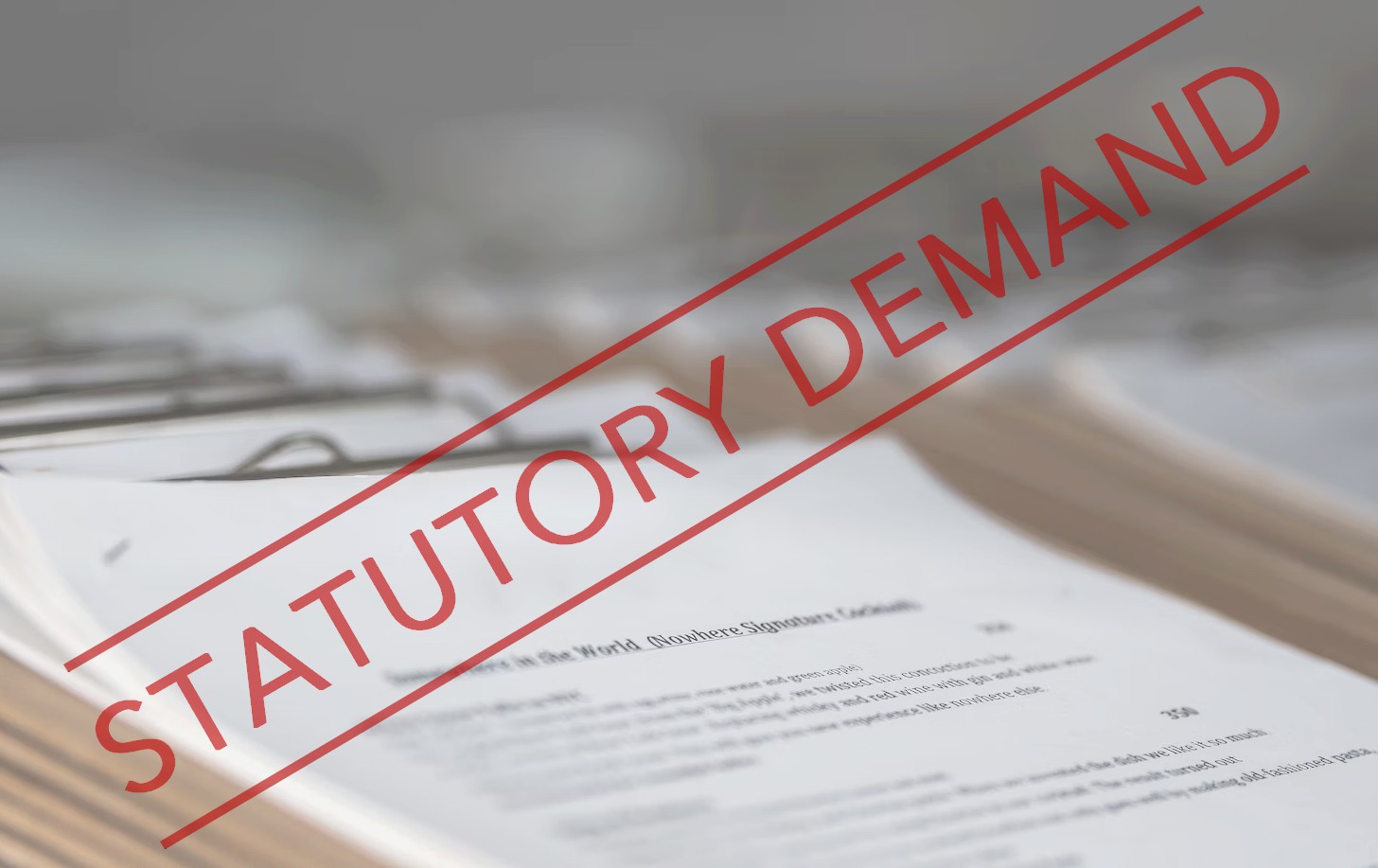 Author: Ian Aldridge, Progressive Legal
Author: Ian Aldridge, Progressive Legal

Statutory Demand: How Does It Work?

If you’re a creditor trying to get back money owed by a company in Australia, you might have come across something called a statutory demand.
On this page, we’ll discuss statutory demands in Australia, including who can issue them, the formal requirements, delivery methods, associated risks, response strategies when receiving one, and the process for canceling a statutory demand if needed.
Need help with a statutory demand?
Contact Progressive Legal for expert dispute resolution legal advice.
REQUEST OUR ADVICEWhat is a Statutory Demand?
A statutory demand is a formal legal notice used in Australia to request payment of a debt owed by a registered company under the Corporations Act 2001 (Cth) (“the Act”).
Its primary purpose is to prompt the debtor company to settle its outstanding debt within 21 days. This document plays a crucial role in debt recovery proceedings, as it signals a creditor’s intention to take legal action if the debt isn’t settled. If the debtor company fails to meet this obligation, reach a suitable agreement with the creditor, or apply to set aside the debt within the specified timeframe, it will be presumed insolvent.
Understanding the specifics of a statutory demand is essential for both creditors looking to recover their funds and companies on the receiving end, as it carries legal consequences that can significantly impact all parties involved.
Who issues a Statutory Demand?
Statutory demands typically come into play in situations involving unpaid, clear-cut debts. This often includes cases where there is a liquidated debt awaiting payment, such as an outstanding invoice for services rendered.
Another common scenario is when a debtor fails to settle a court-ordered judgment debt, despite a court ruling in favor of the creditor. These demands serve as a vital legal tool for creditors seeking resolution in cases of unpaid debts and unpaid judgments, allowing them to pursue appropriate action under the law.
Issuing a statutory demand with Form 509h of the Corporations Act
Form 509h is the official form used to issue a statutory demand under the Act. Creating a valid statutory demand involves completing specific sections of the form accurately. When filling it out, you’ll need to provide:
Creditor Information
This includes the creditor’s name, address, and contact details.
Debtor Details
For the company owing the debt, you’ll need their name and Australian Company Number (ACN). It’s crucial to correctly identify the debtor, whether it’s a company or an individual. Avoid identifying directors or unrelated entities.
Debt Amount
Clearly state the amount owed by the company to the creditor. This amount can represent a single debt or multiple debts. Accuracy is essential to comply with Section 9 of the Corporations Act.
Due Date
Indicate when the debt became due and payable.
Security Information
Include any details about security held by the creditor concerning the debt.
Service Details
Mention the date and method used to serve the demand.
Instructions to the Debtor
Specify what actions you expect the debtor to take.
Additionally, apart from completing Form 509h, several other formal requirements must be met for a statutory demand to be valid, which we’ll discuss further below. For assistance in ensuring a valid statutory demand, reach out to us at Progressive Legal. We’re here to help you navigate this process smoothly.
What are the formal requirements of a statutory demand?
To issue a valid statutory demand in Australia, specific formal requirements must be met, including:
Debt Amount
The debt owed by the company to the creditor must be at least $4,000 (at the time of publication).
Due and Payable
The debt must be due and payable.
Written Demand
The demand must be in writing and adhere to the stipulations outlined in the Corporations Act.
Proper Service
It must be served on the company following the requirements of the Corporations Act.
Clarity
The demand must be clear and unambiguous, specifying the debt amount, its details (including the due date), and a payment deadline, which must be a minimum of 21 days from the service date.
If you’re considering issuing a statutory demand, our experienced dispute resolution lawyers will ensure it meets all legal requirements. Contact us today for expert guidance by requesting our advice below.
How do I serve a statutory demand?
To ensure the validity of a statutory demand in Australia, proper service is crucial, as outlined in Section 109X of the Act. This can be accomplished through the following methods:
- Hand Delivery: The demand should be hand-delivered to a director or another authorized officer of the company.
- Postal Service: Posting the demand to the company’s registered office or primary place of business.
- In-Person Delivery: Leaving the demand at the company’s registered office or primary place of business.
- Notice Address: If a liquidator, administrator, or restructuring practitioner has been appointed for the company, the demand should be left at the address provided in the most recent notice lodged with ASIC.
It’s crucial to serve the demand correctly; otherwise, the company might have grounds to challenge its validity.
What are the dangers of issuing a statutory demand?
While statutory demands can be an effective way for creditors to recover debts from companies, there are also significant risks involved in issuing them. If the company fails to comply with the demand within 21 days, it is deemed to have committed an act of insolvency. This means that the company may be wound up by the Court, and its assets may be sold to pay off its debts.
However, if the company disputes the debt or if it is able to prove that there is a defect in the demand (i.e. the creditor made a mistake in the demand), it may apply to have the demand set aside.
In such instances, costs may be substantial and could even exceed the amount of the debt owed to the creditor. Additonally, if the creditor issues a demand in bad faith or for an improper purpose, the creditor may be liable for damages.
What do I do if I have received a statutory demand?
If your company has received a statutory demand, it’s crucial to act promptly. You can request to have the demand set aside under s 459G of the Act and you have a 21-day window from the date of receiving the demand to either pay the debt in full or apply for its removal. Failing to do so may lead to the company being seen as insolvent.
To apply for setting aside the demand, you must submit an application with an accompanying affidavit to the appropriate court within 21 days of receiving the demand. Make sure to serve the application on the person who served the affidavit.
However, there are various grounds on which you might be able to have the demand set aside, including:
- If the debt is genuinely disputed.
- If there’s a significant defect in the demand, and not setting it aside would cause substantial injustice. It’s important to note that a defect alone may not lead to setting aside the demand; the court must be convinced that it would cause substantial harm to the debtor. For instance, if the demand lacks sufficient details to identify the debt.
- If the demand is considered an abuse of the legal process.
- If the company has a legitimate offsetting claim.
If you’re thinking of applying to have the statutory demand set aside, it’s crucial to seek urgent legal advice from experts since time is of the essence. Don’t delay in taking action, reach out to our experienced litigation lawyers below.
Setting aside a statutory demand
When a statutory demand is received, a company has the option to contest it in court within 21 days of proper service. Note that no extensions are granted, even with creditor consent.
Genuine Dispute
One valid reason to challenge the demand is if there exists a genuine dispute regarding the debt’s amount or the circumstances surrounding its origin.
Offsetting Claim
Companies can seek to set aside the demand if they hold an immediate counterclaim, even if it’s not a specific sum of money (e.g., potential damages from a lawsuit).
Defect in the Demand
Errors in the demand, such as an inaccurate debt amount, misdescriptions, or other irregularities, provide a valid ground for challenge.
Other Reasons
Additional factors that may lead to setting aside the demand include an invalid supporting affidavit, a significant time gap between the affidavit and the demand, or if the demand is considered an abuse of the legal process. In such cases, prompt action is crucial.
Key Takeaways
Statutory demands can be a powerful tool for creditors seeking to recover debts from companies in Australia. However, it is important to ensure that the demand is issued in accordance with the requirements of the Corporations Act 2001 (Cth), and that it is served correctly.
If you’ve received a statutory demand or are considering issuing one, Progressive Legal is here to assist you every step of the way. Our experienced litigation lawyers specialise in handling statutory demand matters and can provide you with expert guidance and representation.
Don’t hesitate to reach out to us today for a tailored no-obligation consultation and find out how we can help safeguard your interests and navigate the legal complexities involved. Your financial stability is our priority; contact us on 1800 820 083 or request our advice below.
Need help with a statutory demand?
Contact us by giving us a call on 1800 820 083 or request our advice below.
REQUEST OUR ADVICENeed Dispute Resolution Help?
Please get in touch with us today via phone or the contact form on this page.


